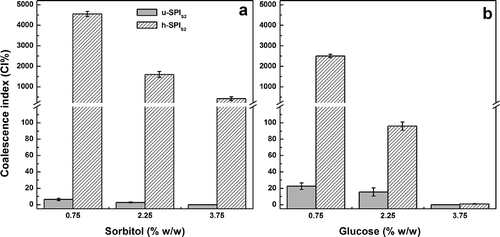Figures & data
Table 1 Protein solubility index (PSI) of unheated (u) and heated (h) aqueous dispersions (2.0% protein w/w in sodium phosphate buffer 10 mM, pH 7.0) prepared with fresh (SPIF) and stored (SPIS1 and SPIS2) soy protein isolates
FIGURE 1 Particle size distributions of unfrozen o/w emulsions prepared with fresh (a: SPIF) and stored (b: SPIS1; c: SPIS2) soy protein samples.
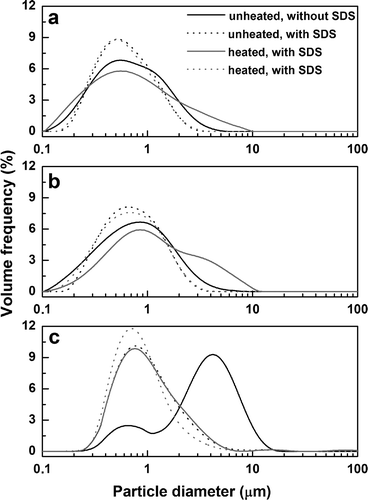
Table 2 De Brouckere (D4,3, volume-weighted) moment mean diameters and flocculation index (FI%) of o/w emulsions prepared with unheated (u) and heated (h) aqueous dispersions of fresh (SPIF) and stored (SPIS1, SPIS2) soy protein isolates. D4,3 values were obtained from particle size distributions measured in the absence (–) and presence (+) of SDS
Table 3 De Brouckere (D4,3, volume-weighted) moment mean values, flocculation index (FI%), coalescence index (CI%) and the amount of free oil (FO) for freeze-thawed o/w emulsions prepared with unheated (u) and heated (h) aqueous dispersions of fresh (SPIF) and stored (SPIS1, SPIS2) soy protein isolates. D4,3 values were obtained from particle size distributions measured in the absence (–) and presence (+) of SDS
FIGURE 2 Microstructure of o/w emulsions prepared with unheated (u) and heated (h) fresh soy protein isolates (SPIF) before and after freeze-thawing (F-T) in the absence or presence of sorbitol (S) at different concentrations. For u-SPIF emulsions: a: unfrozen, b: F-T without cryoprotectant, c: F-T with S (0.75% w/w), d: F-T with S (15.0% w/w); for h-SPIF emulsions, e: unfrozen, f: F-T without cryoprotectant, g: F-T with S (0.75% w/w), h: F-T with S (15.0% w/w). Bar = 10 μm.
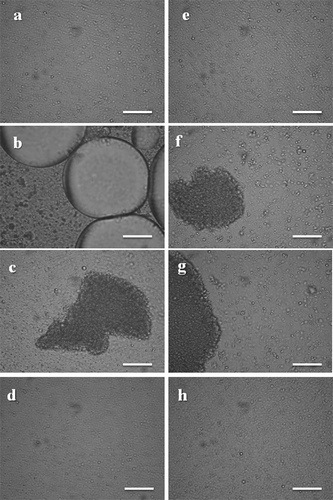
FIGURE 3 De Brouckere (D4,3, volume-weighted) moment mean diameters of freeze-thawed o/w emulsions prepared from unheated a: and heated b: fresh soy protein isolates (SPIF) in the presence of sorbitol (S) at different concentrations (0.75-15.0% w/w in the emulsion). Values are mean of two (n = 2) independent replicates and error bars indicate standard deviation. For comparative purposes, D4,3 values of initial, unfrozen emulsions were also included. For u-SPIF or h-SPIF emulsions measured without SDS, mean values with different lowercase letters indicate significant differences between samples (p < 0.05). For u-SPIF or h-SPIF emulsions measured with SDS, mean values with different uppercase letters indicate significant differences between samples (p < 0.05).
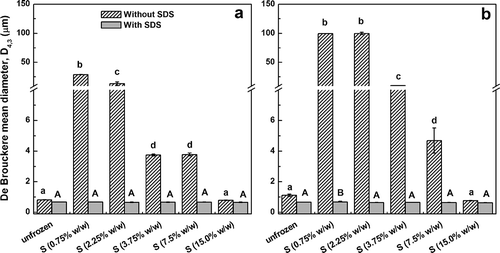
Table 4 Flocculation index (FI%) and coalescence index (CI%) values of freeze-thawed o/w emulsions prepared with unheated and heated fresh and stored (SPIF and SPIS1, respectively) soy protein aqueous dispersions with addition of sorbitol as cryoprotectant at different concentrations (0.75–15.0% w/w in the emulsion)
FIGURE 4 a: Aromatic surface hydrophobicity (H0) of unheated and heated aqueous dispersions prepared with stored soy protein isolates (SPIS1) before (U) and after freeze-thawing (F-T) in the absence (control) and presence of sorbitol (S, 3.0 and 20.0% w/w); b: Freezable water content (FW% w/w) of o/w emulsions prepared with unheated and heated stored soy protein isolates (SPIS1) in the absence (control) and presence of sorbitol (S) as cryoprotectant (0.75–15.0% w/w in the emulsion). H0 and FW values are the mean of two (n = 2) independent replicates ± standard deviation. For dispersions or emulsions prepared with unheated and heated SPIS1 samples, mean values with different lowercase letters are significantly different (p < 0.05).
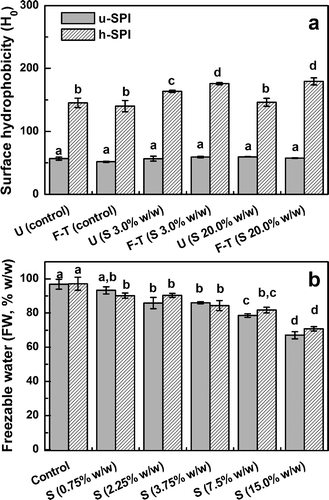
FIGURE 5 Coalescence index (CI%) values of freeze-thawed o/w emulsions prepared with unheated and heated stored soy protein isolates (SPIS2) in the presence of sorbitol a: and glucose b: at different concentrations (0.75–3.75% w/w in the emulsion). CI% values are the mean of two independent (n = 2) replicates ± standard deviation.
